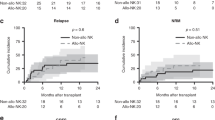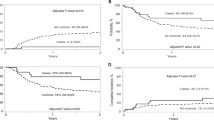Abstract
The focus of this study was to investigate NK cell reconstitution early after hematopoietic stem cell transplantation (HSCT). We were particularly interested in acute myeloid leukemia (AML) since patients with this disease may display an altered NK cell function. The function and the phenotype of donor-derived NK cells obtained from 35 allografted patients 30 and 60 days after HSCT for AML or other-than-AML hematological malignancies has been assessed. NK functional status was investigated by measuring the degranulation capacity (externalization of CD107a) of NK cells against human K562. We also concomitantly determined the concentration of selected cytokines known to modulate NK function and/or receptor expression. At day 30, donor-derived AML and non-AML NK cells could efficiently degranulate when exposed to leukemic K562 targets. At day 60, we observed a reduced NK degranulation potential in AML patients only. Decreased NK activity in AML patients was concomitant to NKp46 and NKp30 down-regulation. AML NK cells were chronically exposed to low IL-2 levels following HSCT. TGF-β1 was undetectable in all patients. In AML, the functional activity of donor-derived NK cells is remarkable at day 30 but may strongly decrease two months after HSCT. Therefore, in this condition, early NK immune-modulation might improve HSCT outcome.
This is a preview of subscription content, access via your institution
Access options
Subscribe to this journal
Receive 12 print issues and online access
$259.00 per year
only $21.58 per issue
Buy this article
- Purchase on Springer Link
- Instant access to full article PDF
Prices may be subject to local taxes which are calculated during checkout




Similar content being viewed by others
References
Biron CA, Nguyen KB, Pien GC, Cousens LP, Salazar-Mather TP . Natural killer cells in antiviral defense: function and regulation by innate cytokines. Annu Rev Immunol 1999; 17: 189–220.
Moretta A, Bottino C, Mingari MC, Biassoni R, Moretta L . What is a natural killer cell? Nat Immunol 2002; 3: 6–8.
Trinchieri G . Biology of natural killer cells. Adv Immunol 1989; 47: 187–376.
Long EO . Regulation of immune responses through inhibitory receptors. Annu Rev Immunol 1999; 17: 875–904.
Bryceson YT, March ME, Ljunggren HG, Long EO . Activation, coactivation, and costimulation of resting human natural killer cells. Immunol Rev 2006; 214: 73–91.
Braud VM, Allan DS, O’Callaghan CA, Soderstrom K, D’Andrea A, Ogg GS et al. HLA-E binds to natural killer cell receptors CD94/NKG2A, B and C. Nature 1998; 391: 795–799.
Ravetch JV, Lanier LL . Immune inhibitory receptors. Science 2000; 290: 84–89.
Parham P . MHC class I molecules and KIRs in human history, health and survival. Nat Rev Immunol 2005; 5: 201–214.
Sivori S, Vitale M, Morelli L, Sanseverino L, Augugliaro R, Bottino C et al. P46, a novel natural killer cell-specific surface molecule that mediates cell activation. J Exp Med 1997; 186: 1129–1136.
Pessino A, Sivori S, Bottino C, Malaspina A, Morelli L, Moretta L et al. Molecular cloning of NKp46: a novel member of the immunoglobulin superfamily involved in triggering of natural cytotoxicity. J Exp Med 1998; 188: 953–960.
Vitale M, Bottino C, Sivori S, Sanseverino L, Castriconi R, Marcenaro E et al. NKp44, a novel triggering surface molecule specifically expressed by activated natural killer cells, is involved in non-major histocompatibility complex-restricted tumor cell lysis. J Exp Med 1998; 187: 2065–2072.
Pende D, Parolini S, Pessino A, Sivori S, Augugliaro R, Morelli L et al. Identification and molecular characterization of NKp30, a novel triggering receptor involved in natural cytotoxicity mediated by human natural killer cells. J Exp Med 1999; 190: 1505–1516.
Glienke J, Sobanov Y, Brostjan C, Steffens C, Nguyen C, Lehrach H et al. The genomic organization of NKG2C, E, F, and D receptor genes in the human natural killer gene complex. Immunogenetics 1998; 48: 163–173.
Bauer S, Groh V, Wu J, Steinle A, Phillips JH, Lanier LL et al. Activation of NK cells and T cells by NKG2D, a receptor for stress-inducible MICA. Science 1999; 285: 727–729.
Cosman D, Mullberg J, Sutherland CL, Chin W, Armitage R, Fanslow W et al. ULBPs, novel MHC class I-related molecules, bind to CMV glycoprotein UL16 and stimulate NK cytotoxicity through the NKG2D receptor. Immunity 2001; 14: 123–133.
Sutherland CL, Chalupny NJ, Cosman D . The UL16-binding proteins, a novel family of MHC class I-related ligands for NKG2D, activate natural killer cell functions. Immunol Rev 2001; 181: 185–192.
Biassoni R, Cantoni C, Falco M, Verdiani S, Bottino C, Vitale M et al. The human leukocyte antigen (HLA)-C-specific ‘activatory’ or ‘inhibitory’ natural killer cell receptors display highly homologous extracellular domains but differ in their transmembrane and intracytoplasmic portions. J Exp Med 1996; 183: 645–650.
Atkinson EA, Gerrard JM, Hildes GE, Greenberg AH . Studies of the mechanism of natural killer (NK) degranulation and cytotoxicity. J Leukoc Biol 1990; 47: 39–48.
Berke G . The binding and lysis of target cells by cytotoxic lymphocytes: molecular and cellular aspects. Annu Rev Immunol 1994; 12: 735–773.
Trambas CM, Griffiths GM . Delivering the kiss of death. Nat Immunol 2003; 4: 399–403.
Horowitz MM, Gale RP, Sondel PM, Goldman JM, Kersey J, Kolb HJ et al. Graft-versus-leukemia reactions after bone marrow transplantation. Blood 1990; 75: 555–562.
Vitale C, Chiossone L, Morreale G, Lanino E, Cottalasso F, Moretti S et al. Analysis of the activating receptors and cytolytic function of human natural killer cells undergoing in-vivo differentiation after allogeneic bone marrow transplantation. Eur J Immunol 2004; 34: 455–460.
Velardi A, Ruggeri L, Moretta A, Moretta L . NK cells: a lesson from mismatched hematopoietic transplantation. Trends Immunol 2002; 23: 438–444.
Ruggeri L, Capanni M, Urbani E, Perruccio K, Shlomchik WD, Tosti A et al. Effectiveness of donor natural killer cell alloreactivity in mismatched hematopoietic transplants. Science 2002; 295: 2097–2100.
Tajima F, Kawatani T, Endo A, Kawasaki H . Natural killer cell activity and cytokine production as prognostic factors in adult acute leukemia. Leukemia 1996; 10: 478–482.
Costello RT, Sivori S, Marcenaro E, Lafage-Pochitaloff M, Mozziconacci MJ, Reviron D et al. Defective expression and function of natural killer cell-triggering receptors in patients with acute myeloid leukemia. Blood 2002; 99: 3661–3667.
Fauriat C, Just-Landi S, Mallet F, Arnoulet C, Sainty D, Olive D et al. Deficient expression of NCR in NK cells from acute myeloid leukemia: evolution during leukemia treatment and impact of leukemia cells in NCRdull phenotype induction. Blood 2007; 109: 323–330.
Savani BN, Mielke S, Adams S, Uribe M, Rezvani K, Yong AS et al. Rapid natural killer cell recovery determines outcome after T-cell-depleted HLA-identical stem cell transplantation in patients with myeloid leukemias but not with acute lymphoblastic leukemia. Leukemia 2007; 21: 2145–2152 (10.1038/sj.leu.2404892).
Alter G, Malenfant JM, Altfeld M . CD107a as a functional marker for the identification of natural killer cell activity. J Immunol Methods 2004; 294: 15–22.
Vitale C, Chiossone L, Morreale G, Lanino E, Cottalasso F, Moretti S et al. Human natural killer cells undergoing in vivo differentiation after allogeneic bone marrow transplantation: analysis of the surface expression and function of activating NK receptors. Mol Immunol 2005; 42: 405–411.
Cooper MA, Bush JE, Fehniger TA, VanDeusen JB, Waite RE, Liu Y et al. In vivo evidence for a dependence on interleukin 15 for survival of natural killer cells. Blood 2002; 100: 3633–3638.
Koka R, Burkett PR, Chien M, Chai S, Chan F, Lodolce JP et al. Interleukin (IL)-15R[alpha]-deficient natural killer cells survive in normal but not IL-15R[alpha]-deficient mice. J Exp Med 2003; 197: 977–984.
Biber JL, Jabbour S, Parihar R, Dierksheide J, Hu Y, Baumann H et al. Administration of two macrophage-derived interferon-gamma-inducing factors (IL-12 and IL-15) induces a lethal systemic inflammatory response in mice that is dependent on natural killer cells but does not require interferon-gamma. Cell Immunol 2002; 216: 31–42.
Castriconi R, Cantoni C, Della Chiesa M, Vitale M, Marcenaro E, Conte R et al. Transforming growth factor beta 1 inhibits expression of NKp30 and NKG2D receptors: consequences for the NK-mediated killing of dendritic cells. Proc Natl Acad Sci USA 2003; 100: 4120–4125.
Ferlazzo G, Tsang ML, Moretta L, Melioli G, Steinman RM, Munz C . Human dendritic cells activate resting natural killer (NK) cells and are recognized via the NKp30 receptor by activated NK cells. J Exp Med 2002; 195: 343–351.
Vitale M, Della Chiesa M, Carlomagno S, Pende D, Arico M, Moretta L et al. NK-dependent DC maturation is mediated by TNFalpha and IFNgamma released upon engagement of the NKp30 triggering receptor. Blood 2005; 106: 566–571.
Acknowledgements
This work was supported by grants from INSERM, and la Fondation de France (comité contre la leucémie) and l’association Laurette Fugain. GP held a joint grant from the National Cancer Institute (INCa) of France and the National Institutes of Health (JRPFP). GF was awarded a Leonardo Da Vinci mobility project scholarship.
Author information
Authors and Affiliations
Corresponding author
Ethics declarations
Competing interests
The authors declare no conflict of interest.
Rights and permissions
About this article
Cite this article
Pittari, G., Fregni, G., Roguet, L. et al. Early evaluation of natural killer activity in post-transplant acute myeloid leukemia patients. Bone Marrow Transplant 45, 862–871 (2010). https://doi.org/10.1038/bmt.2009.265
Received:
Revised:
Accepted:
Published:
Issue Date:
DOI: https://doi.org/10.1038/bmt.2009.265
Keywords
This article is cited by
-
Natural killer cell-based immunotherapy for acute myeloid leukemia
Journal of Hematology & Oncology (2020)
-
The Role of Natural Killer Cells as a Platform for Immunotherapy in Pediatric Cancers
Current Oncology Reports (2019)
-
CD123 target validation and preclinical evaluation of ADCC activity of anti-CD123 antibody CSL362 in combination with NKs from AML patients in remission
Blood Cancer Journal (2017)
-
Natural killer cell immune escape in acute myeloid leukemia
Leukemia (2012)



